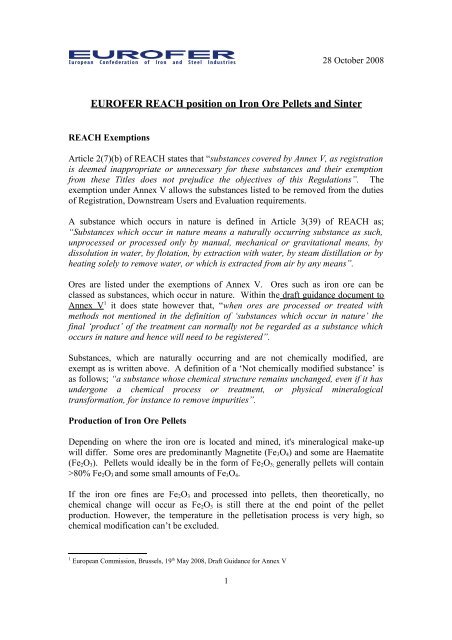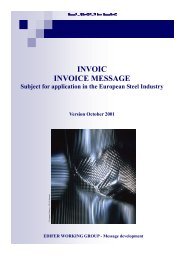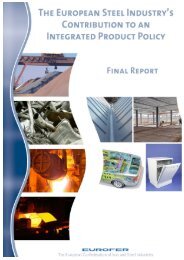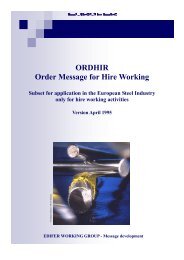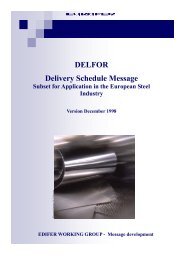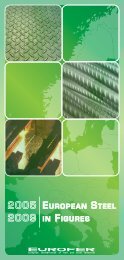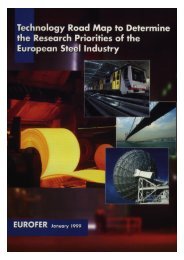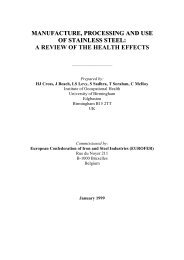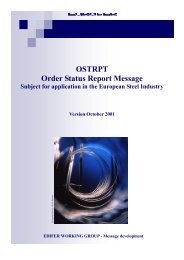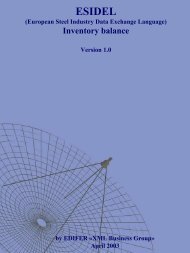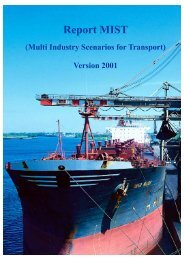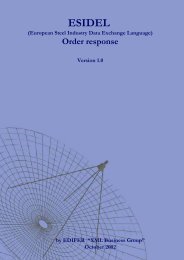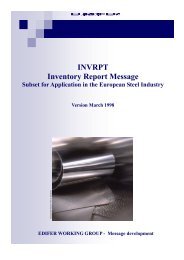EUROFER REACH position on Iron Ore Pellets and Sinter. 28 ...
EUROFER REACH position on Iron Ore Pellets and Sinter. 28 ...
EUROFER REACH position on Iron Ore Pellets and Sinter. 28 ...
You also want an ePaper? Increase the reach of your titles
YUMPU automatically turns print PDFs into web optimized ePapers that Google loves.
<strong>28</strong> October 2008<br />
<str<strong>on</strong>g>EUROFER</str<strong>on</strong>g> <str<strong>on</strong>g>REACH</str<strong>on</strong>g> <str<strong>on</strong>g>positi<strong>on</strong></str<strong>on</strong>g> <strong>on</strong> Ir<strong>on</strong> <strong>Ore</strong> <strong>Pellets</strong> <strong>and</strong> <strong>Sinter</strong><br />
<str<strong>on</strong>g>REACH</str<strong>on</strong>g> Exempti<strong>on</strong>s<br />
Article 2(7)(b) of <str<strong>on</strong>g>REACH</str<strong>on</strong>g> states that “substances covered by Annex V, as registrati<strong>on</strong><br />
is deemed inappropriate or unnecessary for these substances <strong>and</strong> their exempti<strong>on</strong><br />
from these Titles does not prejudice the objectives of this Regulati<strong>on</strong>s”. The<br />
exempti<strong>on</strong> under Annex V allows the substances listed to be removed from the duties<br />
of Registrati<strong>on</strong>, Downstream Users <strong>and</strong> Evaluati<strong>on</strong> requirements.<br />
A substance which occurs in nature is defined in Article 3(39) of <str<strong>on</strong>g>REACH</str<strong>on</strong>g> as;<br />
“Substances which occur in nature means a naturally occurring substance as such,<br />
unprocessed or processed <strong>on</strong>ly by manual, mechanical or gravitati<strong>on</strong>al means, by<br />
dissoluti<strong>on</strong> in water, by flotati<strong>on</strong>, by extracti<strong>on</strong> with water, by steam distillati<strong>on</strong> or by<br />
heating solely to remove water, or which is extracted from air by any means”.<br />
<strong>Ore</strong>s are listed under the exempti<strong>on</strong>s of Annex V. <strong>Ore</strong>s such as ir<strong>on</strong> ore can be<br />
classed as substances, which occur in nature. Within the draft guidance document to<br />
Annex V 1 it does state however that, “when ores are processed or treated with<br />
methods not menti<strong>on</strong>ed in the definiti<strong>on</strong> of ‘substances which occur in nature’ the<br />
final ‘product’ of the treatment can normally not be regarded as a substance which<br />
occurs in nature <strong>and</strong> hence will need to be registered”.<br />
Substances, which are naturally occurring <strong>and</strong> are not chemically modified, are<br />
exempt as is written above. A definiti<strong>on</strong> of a ‘Not chemically modified substance’ is<br />
as follows; “a substance whose chemical structure remains unchanged, even if it has<br />
underg<strong>on</strong>e a chemical process or treatment, or physical mineralogical<br />
transformati<strong>on</strong>, for instance to remove impurities”.<br />
Producti<strong>on</strong> of Ir<strong>on</strong> <strong>Ore</strong> <strong>Pellets</strong><br />
Depending <strong>on</strong> where the ir<strong>on</strong> ore is located <strong>and</strong> mined, it's mineralogical make-up<br />
will differ. Some ores are predominantly Magnetite (Fe3O4) <strong>and</strong> some are Haematite<br />
(Fe2O3). <strong>Pellets</strong> would ideally be in the form of Fe2O3; generally pellets will c<strong>on</strong>tain<br />
>80% Fe2O3 <strong>and</strong> some small amounts of Fe3O4.<br />
If the ir<strong>on</strong> ore fines are Fe2O3 <strong>and</strong> processed into pellets, then theoretically, no<br />
chemical change will occur as Fe2O3 is still there at the end point of the pellet<br />
producti<strong>on</strong>. However, the temperature in the pelletisati<strong>on</strong> process is very high, so<br />
chemical modificati<strong>on</strong> can’t be excluded.<br />
1 European Commissi<strong>on</strong>, Brussels, 19 th May 2008, Draft Guidance for Annex V<br />
1
<strong>28</strong> October 2008<br />
If the ir<strong>on</strong> ore fines are Fe3O4 <strong>and</strong> processed into pellets (at temperature), then<br />
oxidati<strong>on</strong> would almost certainly take place causing a chemical modificati<strong>on</strong> to take<br />
place, forming Fe2O3 at the end point. This, according to the definiti<strong>on</strong>s as listed<br />
above, is a chemical modificati<strong>on</strong> <strong>and</strong> therefore causes that particular Fe2O3<br />
registrati<strong>on</strong> under <str<strong>on</strong>g>REACH</str<strong>on</strong>g> is required.<br />
The additi<strong>on</strong>s within the pellets (e.g. olivine <strong>and</strong> bent<strong>on</strong>ite) will not be chemically<br />
modified.<br />
Producti<strong>on</strong> of <strong>Sinter</strong><br />
Independent from the ir<strong>on</strong> ore (magnetite or haematite), sinter typically c<strong>on</strong>tains about<br />
5-15% FeO in the end (besides e.g. Fe, Fe2O3 <strong>and</strong> CaO), so reducti<strong>on</strong> will always take<br />
place. This is defined as a chemical modificati<strong>on</strong> <strong>and</strong> therefore requires registrati<strong>on</strong><br />
under <str<strong>on</strong>g>REACH</str<strong>on</strong>g>.<br />
C<strong>on</strong>clusi<strong>on</strong>s<br />
• Ir<strong>on</strong> ore pellets: (pre-)registrati<strong>on</strong> is recommended, even if the source is<br />
haematite.<br />
• <strong>Sinter</strong>: chemical modificati<strong>on</strong> to form e.g. FeO has taken place, so<br />
(pre-)registrati<strong>on</strong> is recommended.<br />
"Important Notice: This <str<strong>on</strong>g>positi<strong>on</strong></str<strong>on</strong>g> paper is intended as a supplement to the <str<strong>on</strong>g>REACH</str<strong>on</strong>g> Regulati<strong>on</strong> <strong>and</strong> the<br />
official <str<strong>on</strong>g>REACH</str<strong>on</strong>g> Technical Guidance Documents published by the European Chemicals Agency<br />
(ECHA). It is provided as an advisory document <strong>and</strong>, as such, has no legal st<strong>and</strong>ing. Therefore, in<br />
c<strong>on</strong>juncti<strong>on</strong> with this <str<strong>on</strong>g>positi<strong>on</strong></str<strong>on</strong>g> paper, users are advised to c<strong>on</strong>sult Regulati<strong>on</strong> EC 1907/2006 (for the<br />
legally binding requirements of <str<strong>on</strong>g>REACH</str<strong>on</strong>g>) <strong>and</strong> the official <str<strong>on</strong>g>REACH</str<strong>on</strong>g> Technical Guidance Documents (for<br />
detailed informati<strong>on</strong> <strong>on</strong> <str<strong>on</strong>g>REACH</str<strong>on</strong>g> implementati<strong>on</strong>). It may also be appropriate to seek independent<br />
legal advice <strong>on</strong> matters related to pre-registrati<strong>on</strong> <strong>and</strong> registrati<strong>on</strong>. While every effort has been made<br />
to ensure the accuracy of this document, neither Eurofer nor the authors of this document accept<br />
liability for its c<strong>on</strong>tent or for the use which might be made of the informati<strong>on</strong> herein."<br />
2


